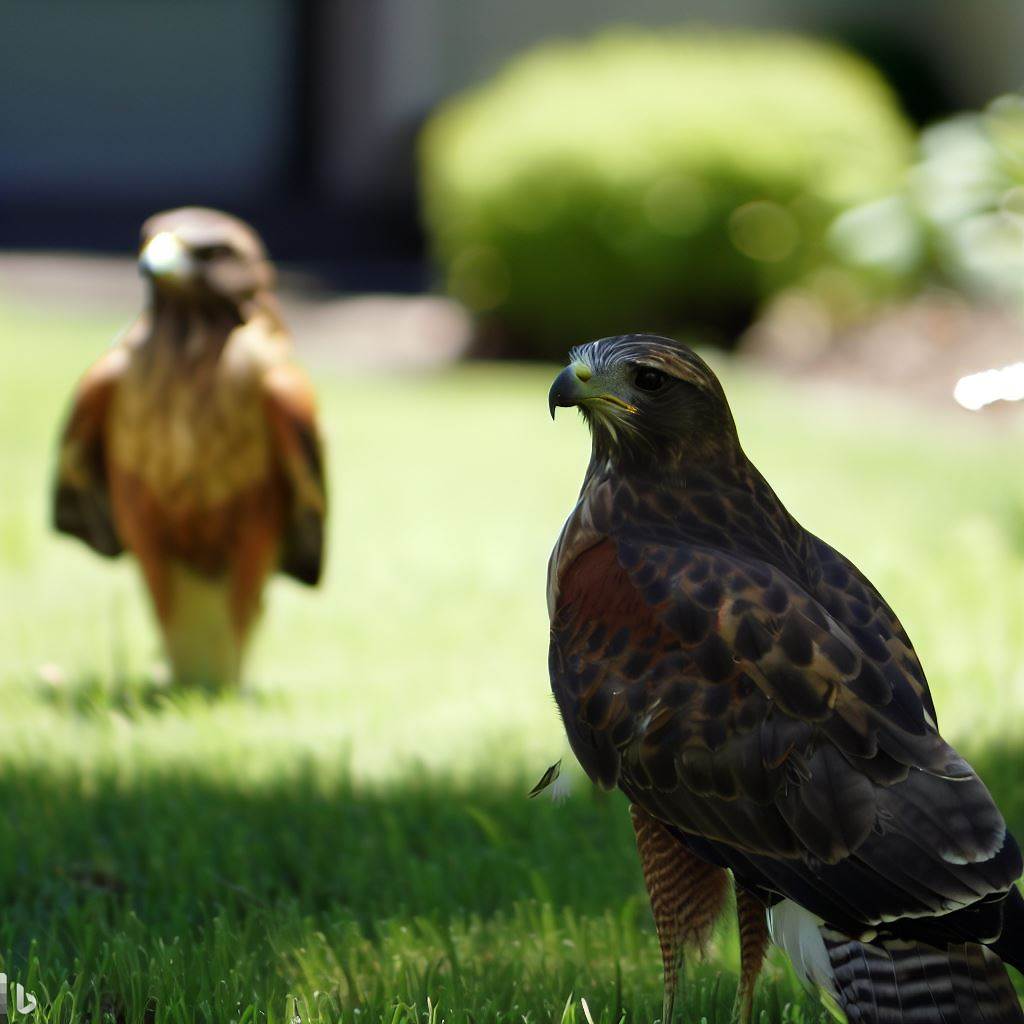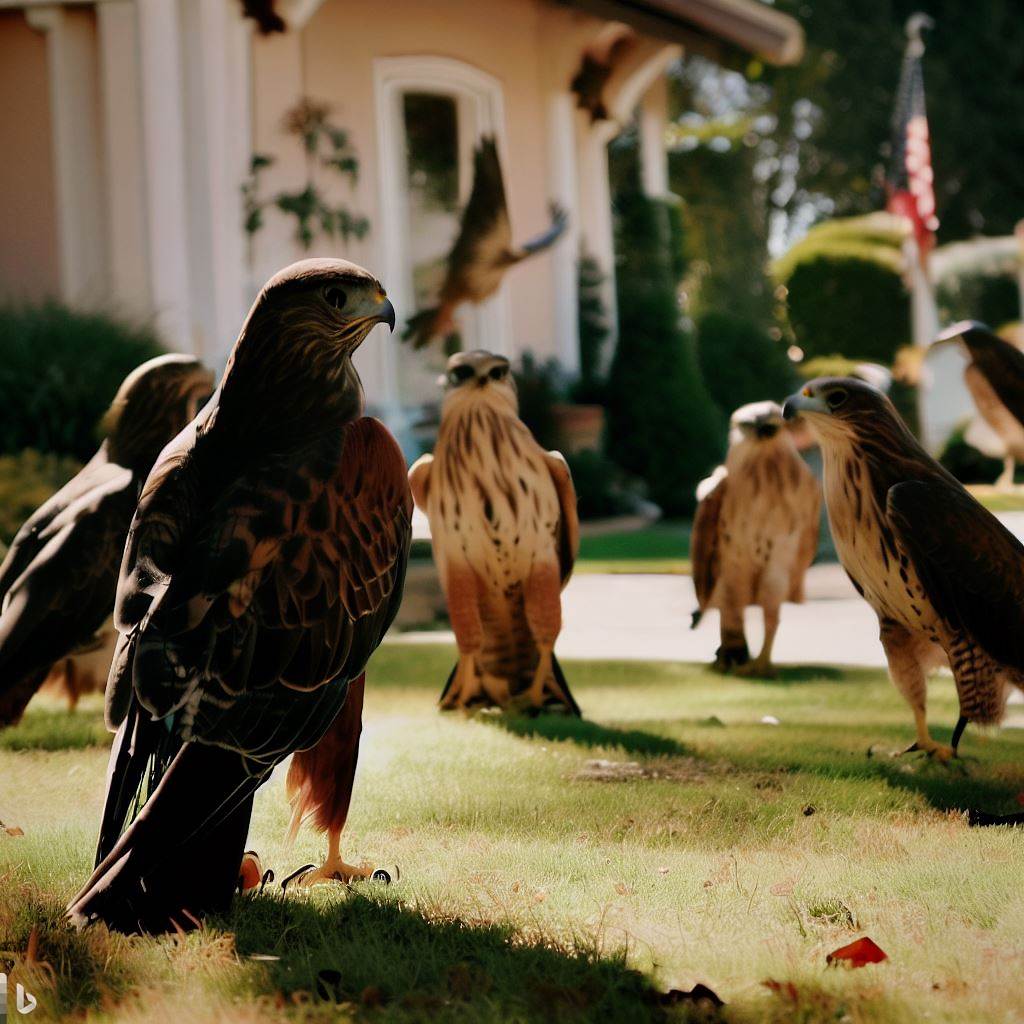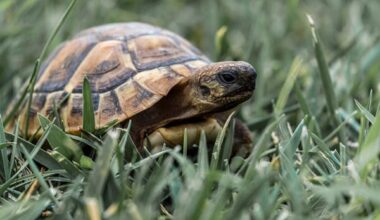So, you’re a fan of the majestic hawk and fancy turning your backyard into a raptor’s paradise? Well, we’d say you’re in for an exciting challenge that will put your birding skills to the test!
Diverging from the familiar scene of seed-pecking feeder visitors, hawks stand as solitary predators with unique requirements.
Remember, these aren’t your typical guests; they’re untamed beings deserving of utmost consideration.
Learn how to attract hawks in your yard and harmonize with the allure of these extraordinary creatures.
But with some careful planning and natural allurements (think native plants and water features), designing a yard that is inviting to these winged wonders can be quite an adventure—our very own backyard version of National Geographic unfolding right before our eyes! Are you ready for the know-how to attract hawks in your yard? I believe so! Let’s dive in.

Creating a Hawk-Friendly Environment
In order to attract hawks to your yard, it is important to create an environment that is suitable for these magnificent birds of prey. Here are some tips on how you can make your yard hawk-friendly:
i. Selecting and Offering Suitable Foods
One of the most effective ways to attract hawks is by offering them suitable foods. Hawks are carnivores and their diet mainly consists of small mammals, birds, and reptiles. To entice them into your yard, consider installing bird feeders that offer food such as mice or rats.
Additionally, if you have a problem with rodents in your area, allowing an abundance of these creatures could naturally draw hawks closer. However, make sure you research local regulations before trying this approach.
ii. Providing Water Sources for Hawks
Hawks require water not only for drinking but also for bathing. By providing water sources such as bird baths or small ponds in your yard, you can greatly increase the chances of attracting hawks.
Optimal Placement of Bird Baths and Ponds
The placement of bird baths and ponds plays a crucial role in attracting hawks. Ideally, they should be placed near trees or other structures where hawks can perch and observe their surroundings while having easy access to the water source.
Offering Secure and Attractive Nesting Sites
If you want hawks to nest in your yard regularly, it is important to provide secure nesting sites. Large trees with sturdy branches are ideal choices for hawk nests as they provide both protection from predators and vantage points from which they can hunt.
Understanding Hawk Behaviors for Better Attraction
Understanding hawk behaviors can greatly increase your chances of attracting them to your yard.
Hawks are known to be territorial birds, so providing ample space and minimal disturbances will make them more likely to visit and potentially nest in your yard.
Plant Choices to Provide Cover and Prey Access
The plants you choose for your yard can have a significant impact on its attractiveness to hawks. Opt for dense shrubs or bushes that provide cover for small mammals and birds—prey that hawks hunt.

This will create an environment where prey is readily available, increasing the likelihood of hawks being drawn to your yard.
Mitigating Risk Factors: Reducing Potential Threats to Hawks
In order to attract hawks, it is important not only to focus on their needs but also mitigate any risk factors that could deter them from visiting or nesting in your yard:
a. Avoid Pesticides: Pesticides used in gardens can contaminate the food chain, ultimately affecting the health of both prey animals and the hawks themselves.
b. Create Safe Flight Paths: Ensure there are no obstacles such as wires or branches that may impede a hawk’s ability to fly freely within your yard.
c. Safeguard Against Predators: Implement measures like installing coyote rollers around trees or using predator deterrent devices near nesting sites to protect eggs and chicks from potential predators.
d. Determine Local Regulations: Familiarize yourself with local laws regarding bird feeding before setting up feeders specifically designed for attracting birds of prey. Depending on where you live, certain regulations may exist due to concerns about introducing non-native species or creating imbalances in local ecosystems.

Conclusion
By following these tips and creating a hawk-friendly environment, you can increase your chances of attracting hawks to your yard. Remember to be patient, as it may take time for these majestic birds to discover and trust your space. Good luck with your hawk-watching adventures!
FAQs On how to attract hawks in your yard
Q: How do I attract hawks to my yard?
A: To attract hawks to your yard, you can create a suitable habitat for them by providing food sources, shelter, and a quiet environment. You can also use large trees or deck railings as perching spots for the hawks.
Q: What kind of food do hawks like?
A: Hawks are raptors, and their main food sources are smaller birds, rodents, and insects. They prey on birds like sparrows, finches, and thrush, as well as rodents and insects.
Q: Can I feed hawks raw meat?
A: It is not recommended to deliberately feed hawks raw meat. Hawks are wild animals and can find their own food. However, if you have a bird feeder, it can attract smaller birds which might attract hawks naturally.
Q: What type of environment do hawks prefer?
A: Hawks like open areas with plenty of hunting grounds. They prefer habitats with large trees for nesting and perching, as well as areas that provide shelter from the wind.
Q: How can I make my yard attractive to hawks?
A: To make your yard attractive to hawks, you can provide a habitat with large trees, open areas for hunting, and a quiet environment. Avoid using pesticides that could harm the hawks’ food sources.
Q: What are some tips for attracting backyard hawks?
A: Some tips for attracting backyard hawks include providing food sources like bird feeders, creating a habitat with large trees or deck railings for perching, and keeping your yard quiet and free from disturbances.
Q: Is it legal to deliberately feed hawks?
A: It is generally not recommended to deliberately feed hawks as it may disrupt their natural hunting patterns. However, if you have a bird feeder, it can indirectly attract hawks by attracting smaller birds that the hawks prey upon.
Q: Can hawks be dangerous to small pets?
A: Hawks are wild animals and can pose a threat to small pets like pet mice or ground birds. It is important to keep your pets supervised and provide them with a safe environment to avoid any potential conflicts with hawks.
Q: How can I attract specific hawk species to my yard?
A: Each hawk species has its own habitat preferences and food sources. To attract specific hawk species, research their habits and create an environment that closely resembles their natural habitat.
Q: Are there any risks associated with attracting hawks to my yard?
A: While hawks generally avoid human interaction, there is a small risk that they may mistake a small pet or child as prey. It is important to keep a safe distance and supervise any small pets or children when hawks are present.
